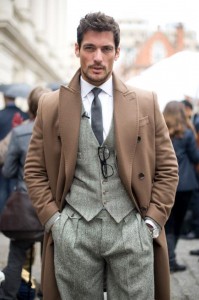Camel Coats
The new starting point is a pair of images of David Gandy. In these images, David is wearing a camel coat, and I’ve not done much, if any, research in coats before.
It should be noted that I don’t much like this example, at first glance. It does look good, but I feel its colours wouldn’t suit me, and I’m a little suspicious of heavy coats in light colours.
It’s claimed that it’s a product of one particular designer, coming from the Max Mara house, in Italy and has only been around since 1981. Naturally, it has been copied a lot, and Max Mara themselves had only made 145,000 by 2011 – the design pretty much unchanged. I’m none too sure if the Max Mara coat was intended for men or women; I see the more generic coats worn by both. The Max Mara website is so dire I can’t actually access it to find out, but an NYT article implies they think of it as a women’s coat.
I was fully expecting this to be something from the 60s or 70s, and probably derived from army greatcoats, but it looks like it’s been a different track – actually coming from a coat worn by polo players in the early twentieth century, and originally with a belt that tied. With variations, it crosses over with the Ulster coat, too. The lasting form, though seems to have lost the belt, and have the double breast. The “camel” bit was genuine in the original; the yarn from which is was made came from Bactrian camels. Nowadays, it’s just a colour, as far as I can determine.
As with many men’s garments, it’s more a vague category than anything defined. The “proper” version seems to be double-breasted, and a coat, not a jacket – Fashionbeans has a good illustrative spread of camel coats, and there are a few varieties there. Despite the origins as an informal, after-the-game garment, it’s now seen as being a formal, winter-y sort of an item, appropriate to wear over a suit. They do, unlike some coats, seem to be worn both open and closed. One detail that I do like in David’s example is the pocket high on the left breast; it gives a lot more definition to the shape of the shoulder there. The heavy stitch in the lapels is interesting too; it doesn’t happen in most versions of the coat, but works particularly well with the tweed underneath.

